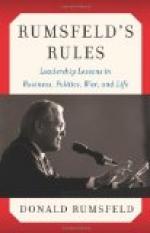The Boer commander evidently counted on reinforcements from all quarters; a party from Colesberg cut off a British waggon train at the Riet on or about Friday, the 16th, and reinforcements from Natal arrived during Cronje’s action. Lord Roberts has thus drawn the Boers away from the circumference towards the centre. He has lightened the tasks of Buller, Clements, Gatacre, and Brabant, but has thereby brought the chief load on to his own shoulders. It seems a misfortune that Cronje was able to escape eastwards from Magersfontein, though it would be wrong until full knowledge of what took place is obtained to assume that this could have been avoided.
Cronje, however, has not been able to make good his escape. A Renter’s telegram from Paardeberg dated. Tuesday explicitly states that Cronje’s force was enclosed and remained enclosed. Lord Roberts on Tuesday reported that after examination of the enemy’s position by reconnaissance in force, he decided to avoid the heavy loss involved in an assault, but to bombard the enemy and to turn his attention to the approaching reinforcements. The result was that the reinforcements were driven off and dispersed with heavy loss to them and trifling loss to the British. This seems to have been effected on Tuesday. Boer prisoners reported that they have come from Ladysmith, and the commander of the reinforcements is said to have been Commandant Botha, who was last heard of at Spion Kop. On Tuesday also the shelling of Cronje’s position is said to have induced him to ask for an armistice, which must be assumed to be the prelude to a surrender; at any rate the request would hardly be granted except to settle the terms of a capitulation or to enable the Boer general to be told that unconditional surrender was the only alternative to a continuance of the bombardment.
The advance into the Free State implied that Lord Roberts meant to take the benefit of acting on “interior lines,” that is, in plain English, of getting in between his enemies and striking them in turn before they can unite or combine. This plan required him with his main body to attack the enemy’s reinforcements in detail as they came up. In that way he secured time for the completion of the action against Cronje, and upon its favourable issue he will be master of the situation.
In Natal the situation has been changed by the action of Lord Roberts. The two Boer Republics are well aware that they must stand or fall together. Either the Boer Commander-in-Chief has decided to strike at Lord Roberts, in which case he must move the bulk of his force into the Free State, or he hopes to be in time to resist Lord Roberts after making an end of Sir George White. In the former case he must raise the siege of Ladysmith, for he cannot carry it on without a strong covering force to resist Sir Redvers Buller. Then there will be forty thousand British troops in Natal, whose advance will be almost as dangerous as that of Lord Roberts. In the




